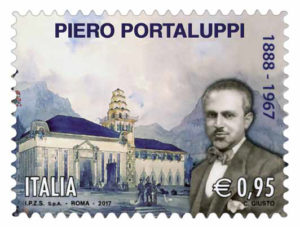Architect Piero Portaluppi was born in Milan in 1888. He graduated at the Faculty of Architecture of the Polytechnic of Milan in 1910, was professor of architectural composition from 1936 and Dean of the Faculty of Architecture of Milan from 1939 to 1963.
Between 1912 and 1930 he created numerous electric power stations in the Alpine region, which were immediately considered symbols of modernity: the most famous at Verampio (1912-1917), Valdo (1920-1923), Crevoladossola (1923-1924), Cadarese (1925-1929). He was professionally attached to his city, where he created public and private buildings – which include the palace with arch in corso Venezia (1926-30), Hoepli Planetarium (1929-30), INA Palace in piazza Diaz (1932-37), Villa Necchi Campiglio (1932-35), Arengario (1937-42, with Enrico Agostino Griffini, Pier Giulio Magistretti, Giovanni Muzio)- the restorations of the Casa degli Atellani (1919-21), the Brera Picture-Gallery (1919-25) and Santa Maria delle Grazie (1929-48). For the Quintavalle Family he created the Villa del Dosso complex (three buildings) at Somma Lombardo (1931-36). In 1926 he won the competition for the Milan Town-Planning Scheme with Marco Semenza. Three years later he was called to create the Italian pavilion for the Universal Exhibition of Barcelona. In the post-war period he intervened on important historic buildings in Milan: the Brera (1946-1963), the San Vittore convent – Museum of Science and Technology (1947-1953), the Major Hospital – State University (from 1949) and the Piccola Scala (1949-1955).
Piero Portaluppi

In 2017 the Italian Post Office dedicated a stamp to him
for the fiftieth anniversary of his death.
